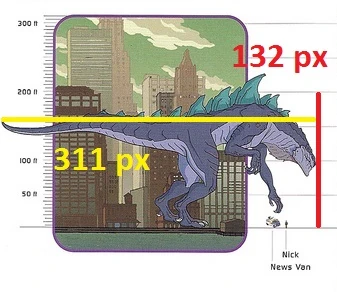Feat[]
In this scene of the Godzilla: The Series episode "Leviathan," Zilla Jr. smashes through an underwater mountain as part of a sneak attack against a Cryptocleidus. Zilla Jr. seems to have slipped behind the rock to wait in hiding.
The chunk of rock that was smashed appears to be significantly bigger than the Cryptocleidus or Zilla Jr.
He doesn't just break the rock, though. The pieces are pushed in his direction of movement a good distance.
Size of Rock (Lowballed)[]
After pixel-scaling a scan of the Godzilla: The Series style guide, Zilla Jr.'s body length is 143.6 meters.

In the image showing Zilla Jr.'s dimensions, the 200-foot mark is 132 px above the 0-foot mark. Zilla Jr.'s length from the tip of his tail to the tip of his nose is 311 px, which translates to 471.21 feet = 143.6 meters.
Quick additional pixel-scaling of Zilla Jr.'s tail shows that his tail is ~78 m long, which is consistent with the official guide for the 1998 movie. Thus, Zilla Jr.'s length is 143.6 meters.
Additionally, the portion of the rock shown when the Cryptocleidus swims up to the top of the mountain is approximately as tall as the Cryptocleidus itself. This chunk of the rock is also wider than it is tall and gets wider with distance from the top.

According to the style guide, the Cryptocleidus is supposed to be about 200 ft. = 60.96 tall with its neck in a less outstretched position.

The above screenshot shows the first frame of the next shot, when the rubble had just started falling down below view (meaning movement was mostly in the horizontal until now). This shows that the height of the rock that was shattered must have exceeded the body length of either monster, as we can see that the Cryptocleidus' body wasn't this long while it was falling.
Since the rock gets wider with distance from the top, and considering that the chunk of rock shattered was taller than Zilla Jr.'s full 143.6-meter body length, I will assume a volume of 60 m x 60 m x 60 m = 216,000 m^3 for a low-balled estimate.
Assuming the rock is made of granite (density = 2.65 g/cm^3 = 2,650 kg/m^3), that gives a mass of 572,400,000 kg = 572,400 metric tons.
Force Exerted[]
I found that there are 14 frames between the rock starting to shatter and Zilla Jr.'s face emerging on the other side. Frames after that show that his body is no longer making contact with the rock. Specifically, I started and finished counting with the following frames, as he's not making contact with the rock anymore after this.

A full second is 25 frames for the video, so the impact lasts 0.56 seconds.
It takes Zilla Jr. and Cryptocleidus 10 frames, or 0.4 seconds, to travel a distance exceeding Jr.'s head+torso length, which I measured here to be ~ 204.54 ft ~ 62 meters.

When the Cryptocleidus sank down into the depths, it did so in the same spot as the rocks, which means the rubble moved at the same speed in the horizontal direction as the creature. Thus, the Cryptocleidus' speed and acceleration is also that of the rubble.
Speed = 62 m / 0.4 s = 155 m/s
Acceleration = 155 m/s / 0.56 s = 276.79 m/s^2
Force = mass * acceleration
Force = 572,400,000 kg * 276.79 m/s^2 = 158,434,596,000 N (~158.4 billion Newtons)
How much mass could this much force lift/throw?[]
According to this, the height of a projectile shooting straight upward is represented by the formula
distance = (vf^2 - vi^2) / (2*g).
Sending a mass 60 m (Zilla Jr.'s height) up into the air:
60 m = (0 m/s - (vi)^2) / 19.6 m/s^2
60 m = (vi)^2 / 19.6 m/s^2
vi = (60 m * 19.6 m/s^2)^1/2 = 34.29 m/s
An object would need to reach a speed of 34.29 m/s to move 60 m upward against gravity.
Reaching a speed of 34.29 m/s from a 0.56-second impact means an acceleration of 61.23 m/s^2.
158,434,596,000 N / 61.23 m/s^2 = 2,587,532,190.1 kg ~ 2.5875 million metric tons
The force exerted by the impact is enough to throw ~2.5875 million metric tons a height of 60 meters!
EDIT 6/14/2017: Updated calculation with new scaling for the rock and new results

